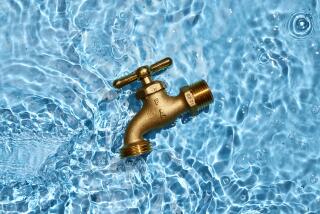WASHINGTON / CATHERINE COLLINS : Radon Devices: Whoâs Regulating Whom?
There is no mandatory nationwide system to ensure the reliability of devices manufactured by hundreds of companies to detect one of todayâs biggest environmental health threats--radon.
At the state level, only nine states have programs to certify radon measurement companies. And four of those programs are voluntary. California has no program.
Radon is a colorless, odorless gas that forms naturally by the decay of radium and uranium. It occurs almost everywhere and seeps from surrounding rocks and soil into buildings through foundations or the water supply.
The concentration of radon in a particular building depends on a number of factors, from the type of construction and condition of the foundation to the permeability of the soil. Neighboring buildings can have very different radon levels.
The Environmental Protection Agency has ranked radon as one of the most serious unaddressed environmental threats today. It is second only to smoking as a cause of lung cancer. About 20,000 deaths are directly attributable to radon exposure.
The EPA has operated a voluntary testing program since 1986, when only 24 companies received the EPAâs seal of approval. By January, 1990, there were 660 companies that had received EPA approval.
Despite this rapid growth in the industry and its participation in the federal program, there are problems. Only 80% of the nationâs radon-measurement companies participate in the EPAâs testing program.
Of those that do participate, about 87% pass, according to the latest report on the credibility of the radon-measurement industry by the General Accounting Office, an investigative arm of Congress.
Even if a company participated in the program and its device passed, there is no requirement for the company to maintain an ongoing quality assurance program to guarantee that all of its devices give consistent results.
In an earlier study, the GAO found that less than half of the companies surveyed calibrated their equipment regularly. By âblind testing,â or performing a second series of tests without the knowledge of the companies, the GAO found that 20% of the type of devices that passed the first time failed the second test.
Further, even if a company fails the test, there is no law that says the firm must comply with the EPAâs suggestions or that it cannot market devices that fail to meet federal standards.
âHomeowners do not have adequate assurance that companies have demonstrated a minimum level of competence in measuring radon and that the test results provided to them have some degree of accuracy,â said the new GAO report.
The GAO report recommends both making participation in the radio measurement program mandatory and implementing an ongoing quality assurance program.
âThis sort of failure rate and lack of protection simply would not be tolerated in any other area of consumer protection,â said a staff member of the House Committee on Science, Space and Technology, which has been examining the issue.
Even with accurate devices, however, there is little indication that the public would care, and that may be the most striking aspect of the radon problem. Only 5% of the houses nationwide have been tested for radon, despite its dangers.
âWhen someone believes that a chemical plant up the river has contaminated his drinking water, he gets outraged. Even if it increases his risk of getting cancer by only one in a million. That is because someone else is responsible,â said Dennis Wagner, chief of the EPAâs radon public information section.
âBut in the case of radon, that person is responsible. When they have to take action themselves, people are more apathetic. Seat belts are a great example.â
On the basis of radon screening in 17 states, the EPA administrator and the assistant surgeon general recommended two years ago that every home be tested for elevated levels of the gas.
There are several do-it-yourself devices available for testing, while some types must be operated by professionals. Accurate measures are important because radon can be eliminated, at fairly reasonable costs, by ventilating the slab or foundation on which a house is built.
The average radon level in U.S. homes is about 1.5 picoCuries. But on the basis of its nationwide survey, the EPA estimates that 10% of all homes have levels in excess of 4 picoCuries, which is comparable to smoking half a package of cigarettes a day.
The EPA is conducting a state-by-state survey of radon levels, which has shown that levels vary widely from house to house, town to town and state to state. So far, Iowa has the dubious honor of having the highest percentage of homes with elevated levels--70%. Alabama has reported the lowest--6%. The EPA survey of California is expected to be released in mid-October.
Because there is no way of gauging a particular houseâs risk, Richard Hembra, director of environmental protection issues at the GAO, said, âThe safest thing to do is to make a small investment and test your home.â
Interestingly, the radon-measurement industry is one that would welcome a mandatory testing program and even regulation. Of 32 companies surveyed by the GAO, 27 said participation should be mandatory.
âItâs a case of protecting the good players,â said a staff member of the House subcommittee on natural resources.
Marvin Goldstein, who owns a testing firm in Philadelphia and is legislative co-chairman of the Assn. of Radon Technologists, said:
âWhen a person buys a house, he should not have to take a chance on excessive exposure to radon that can amount to the equivalent of 200 chest X-rays a year. We require termite inspections when a house is sold and termites donât kill people. We donât require radon inspections, yet radon does kill.
âWe could save thousands of lives a year if homes were inspected for radon.â
Rep. Robert A. Roe (D-N.J.) has sponsored legislation to make the EPA testing program mandatory. It has been attached to the Indoor Air Quality Act, which passed the House Science, Space and Technology Committee in midsummer, but has been stuck in the House Energy and Commerce Committee, which is concentrating on the Clean Air Act.
Despite the GAO recommendations, congressional efforts and industry support, the EPA is reluctant to make evaluation of testing devices mandatory.
âSince its inception, our program has been designed to provide technical assistance at the state level,â said Jed Harrison, chief of mitigation prevention and quality assurance in the radon division of EPA. âWe feel states can design programs to suit their own unique situations.â
The EPA is also working with the National Advertising Council to heighten public awareness of the dangers of radon.
Congress is under constant pressure to deal with environmental issues that the public perceives as important. Once through with outdoor pollution and the clean air bill, Congress will be free to move on to the issue of indoor pollution, which many experts say is a greater danger.
More to Read
Sign up for Essential California
The most important California stories and recommendations in your inbox every morning.
You may occasionally receive promotional content from the Los Angeles Times.










